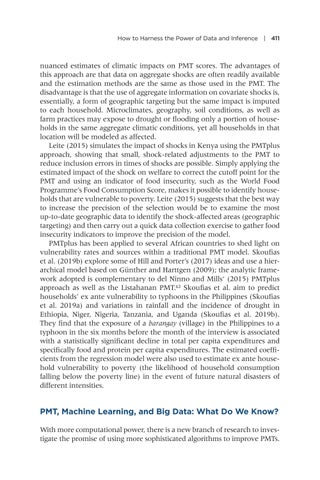How to Harness the Power of Data and Inference | 411
nuanced estimates of climatic impacts on PMT scores. The advantages of this approach are that data on aggregate shocks are often readily available and the estimation methods are the same as those used in the PMT. The disadvantage is that the use of aggregate information on covariate shocks is, essentially, a form of geographic targeting but the same impact is imputed to each household. Microclimates, geography, soil conditions, as well as farm practices may expose to drought or flooding only a portion of households in the same aggregate climatic conditions, yet all households in that location will be modeled as affected. Leite (2015) simulates the impact of shocks in Kenya using the PMTplus approach, showing that small, shock-related adjustments to the PMT to reduce inclusion errors in times of shocks are possible. Simply applying the estimated impact of the shock on welfare to correct the cutoff point for the PMT and using an indicator of food insecurity, such as the World Food Programme’s Food Consumption Score, makes it possible to identify households that are vulnerable to poverty. Leite (2015) suggests that the best way to increase the precision of the selection would be to examine the most up-to-date geographic data to identify the shock-affected areas (geographic targeting) and then carry out a quick data collection exercise to gather food insecurity indicators to improve the precision of the model. PMTplus has been applied to several African countries to shed light on vulnerability rates and sources within a traditional PMT model. Skoufias et al. (2019b) explore some of Hill and Porter’s (2017) ideas and use a hierarchical model based on Günther and Harttgen (2009); the analytic framework adopted is complementary to del Ninno and Mills‘ (2015) PMTplus approach as well as the Listahanan PMT.63 Skoufias et al. aim to predict households’ ex ante vulnerability to typhoons in the Philippines (Skoufias et al. 2019a) and variations in rainfall and the incidence of drought in Ethiopia, Niger, Nigeria, Tanzania, and Uganda (Skoufias et al. 2019b). They find that the exposure of a barangay (village) in the Philippines to a typhoon in the six months before the month of the interview is associated with a statistically significant decline in total per capita expenditures and specifically food and protein per capita expenditures. The estimated coefficients from the regression model were also used to estimate ex ante household vulnerability to poverty (the likelihood of household consumption falling below the poverty line) in the event of future natural disasters of different intensities.
PMT, Machine Learning, and Big Data: What Do We Know? With more computational power, there is a new branch of research to investigate the promise of using more sophisticated algorithms to improve PMTs.


